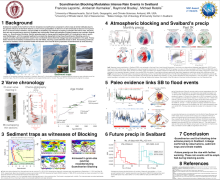Scandinavian and Ural blocking patterns modulate intense rain events in Svalbard
Francois
Lapointe
UMass-Amherst
Poster
In a warmer world, the Arctic region is experiencing significant changes in precipitation patterns, with a notable increase in rainfall. However, these changes are not uniform across seasons and years, as natural variability plays a role in modulating these shifts. Among the areas affected by these hydroclimatic changes, Svalbard stands out due to its proximity to the North Atlantic Ocean, which exerts a considerable influence on its climate.
To better understand these phenomena, we have combined climate data from various sources, including paleoproxies, observations, and climate models. Our findings indicate a strong connection between wet and warm extremes in Svalbard over the past two millennia and the presence of atmospheric blocking regimes over the Scandinavian and/or Ural region. These blocking regimes lead to rainfall episodes, resulting in the deposition of coarse particles and elevated levels of calcium in Linnévatnet, a lake in southwest Spitsbergen. Notably, the coarsest sediments consistently appear during these atmospheric blocking events. Remarkably, this linkage has persisted for the last 1500 years, as revealed by an annually resolved sediment record from Linnévatnet. The sediment analysis demonstrates a millennial-scale decline in Svalbard precipitation over the past 2000 years that was reversed toward increasing values in the mid-1800s. In two models from the CMIP6 that span a wide range of temperature and precipitation projections for the Arctic, results show that the recent trend toward wet conditions in Svalbard is projected to continue in the future. The nature and magnitude of this increase, however, will depend on two critical factors: the rise in sea surface temperature and air temperature in the North-Atlantic, and alterations in the frequency and intensity of atmospheric blocking episodes over the Scandinavian and Ural regions.
To better understand these phenomena, we have combined climate data from various sources, including paleoproxies, observations, and climate models. Our findings indicate a strong connection between wet and warm extremes in Svalbard over the past two millennia and the presence of atmospheric blocking regimes over the Scandinavian and/or Ural region. These blocking regimes lead to rainfall episodes, resulting in the deposition of coarse particles and elevated levels of calcium in Linnévatnet, a lake in southwest Spitsbergen. Notably, the coarsest sediments consistently appear during these atmospheric blocking events. Remarkably, this linkage has persisted for the last 1500 years, as revealed by an annually resolved sediment record from Linnévatnet. The sediment analysis demonstrates a millennial-scale decline in Svalbard precipitation over the past 2000 years that was reversed toward increasing values in the mid-1800s. In two models from the CMIP6 that span a wide range of temperature and precipitation projections for the Arctic, results show that the recent trend toward wet conditions in Svalbard is projected to continue in the future. The nature and magnitude of this increase, however, will depend on two critical factors: the rise in sea surface temperature and air temperature in the North-Atlantic, and alterations in the frequency and intensity of atmospheric blocking episodes over the Scandinavian and Ural regions.

Poster file
Lapointe_Francois_blocking_poster.pdf
(13.71 MB)
Meeting homepage
